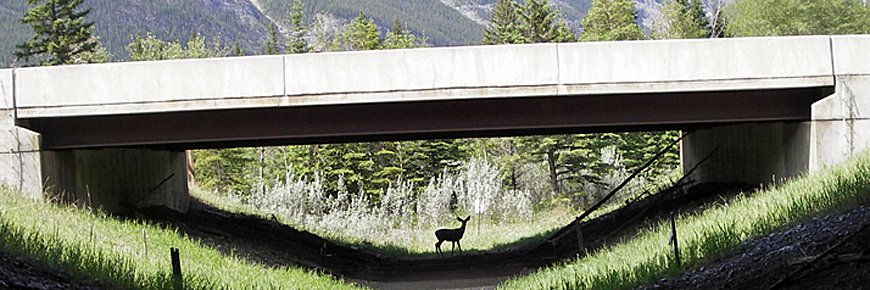
Wildlife Crossings Project on Highway 93 South
Kootenay National Park
Over 5,000 vehicles travel Highway 93 through Kootenay National Park on a typical summer day. To reduce animal-vehicle collisions Parks Canada built fences and nine wildlife crossings on a 15 km section of the highway using the successful program in Banff National Park as a model.
Project FAQ
Project Fact Sheet
Video: Helping Wildlife Cross the Road
Video: Helping Wildlife Cross the Road - The First Winter
Video: Helping Wildlife Cross the Road - The First Spring
What’s the concern?
Collisions between wildlife and vehicles kill animals, damage vehicles and, occasionally, result in human injury or death. In recent years an annual average of 53 large animals have been killed in Kootenay. This statistic does not include those dying out of view from the highway or removed by scavengers before Parks staff can record them. It also excludes hundreds of small mammals, birds, amphibians and reptiles killed each year but rarely reported, and the eight to ten bighorn sheep dying annually in collisions just outside the park.
Roads are also barriers to wildlife searching for food, shelter and mates. For small animals, the pavement and cleared right-of-way can be insurmountable chasms of unsuitable or dangerous terrain. Even some larger species are deterred by vehicles, human activity, and infrastructure. This is especially critical in Kootenay because there is seasonally important habitat on both sides of the highway, which runs through middle of the park.

Confirmed roadkills in Kootenay National Park 2003-2012 before fencing and underpasses were installed. The new crossing structures are being monitored to determine their effectiveness.
What is Parks Canada doing?
 Fencing and wildlife underpasses are in a “hot spot” for wildlife-vehicle collisions on Highway 93S.
Fencing and wildlife underpasses are in a “hot spot” for wildlife-vehicle collisions on Highway 93S.The most effective way to limit wildlife-vehicle collisions while allowing animals to move across the landscape is to fence highways and provide wildlife crossing structures. Highway Fencing and 44 Wildlife Crossings have been completed on the 82 km of the Trans-Canada Highway in Banff National Park. Monitoring since 1996 shows that fencing has reduced animal accidents by at least 80% and facilitated over 160,000 animal crossings through underpasses and overpasses. Similar mitigation measures are recommended for highway segments with high animal-vehicle collision rates in Kootenay.
Deer, mainly white-tailed deer, now make up over 70% of recorded roadkills in Kootenay. In 2013, special funding allowed Parks Canada to fence 4.7 km of road and construct three wildlife underpasses near Dolly Varden Day Use Area on Highway 93S where there is a large deer population. In August 2014, the Government of Canada announced an additional $9.6 million in investment for phase two of the Kootenay Wildlife Crossing Project. In 2015, over ten km of fencing, one box underpass and five elliptical underpasses were constructed. Funds earmarked for this project are part of a multi-year, agency-wide investment to achieve tangible conservation outcomes while connecting Canadians to nature as part of Canada’s National Conservation Plan.
Parks Canada is monitoring how animals are using the new crossing structures that will inform further mitigations and help make future highway travel safer for all animals – including humans.
Parks Canada will continue to take other steps to limit collisions and connect the landscape. This may include establishing seasonal speed advisories or speed limits in high-risk areas, and enforcing speed limits in roadkill hot spots. As funds allow, Parks Canada is also improving culverts and bridges to help aquatic species, such as fish and amphibians cross highways too.

Wolves were the first animals to use Kootenay’s new crossing structures but they were soon joined by bear, white-tailed deer, moose, snowshoe hare and other species.
How can I help?
Your awareness and behaviour is key.
- Stay alert. Keep in mind that animals can appear anywhere along highways in any season. Be particularly careful when passing.
- Obey year-round, seasonal or temporary speed zones posted in areas where animals are at high risk of being hit.
- Report wildlife strikes, even if your vehicle is not damaged. Reporting the exact location helps park staff monitor injured animals, recover dead ones, and plan future wildlife crossings. Park Dispatch: 403-762-1470 (24/7) or Kootenay Resource Conservation Office: 250-347-9361.
Acknowledgements
Wildlife crossing outreach has benefitted from generous support from the Yellowstone to Yukon Conservation Initiative (Y2Y). This valuable funding enabled the purchase of truck-mounted GPS units for the collection of roadside wildlife data, and supported the creation of a series of wildlife crossing illustrations to enhance education and outreach programs.
Related Information
- The Wildlife Collision Prevention Program is administered by the British Columbia Conservation Foundation.

A box culvert underpass in Kootenay National Park. The fencing directs wildlife to the crossing structure.
Related links
- Date modified :